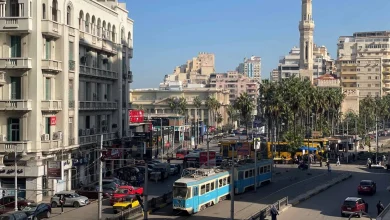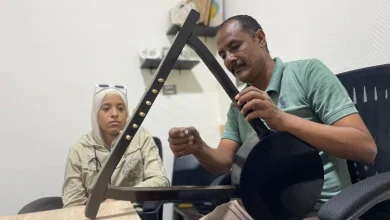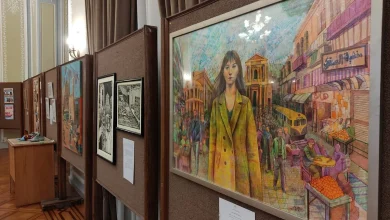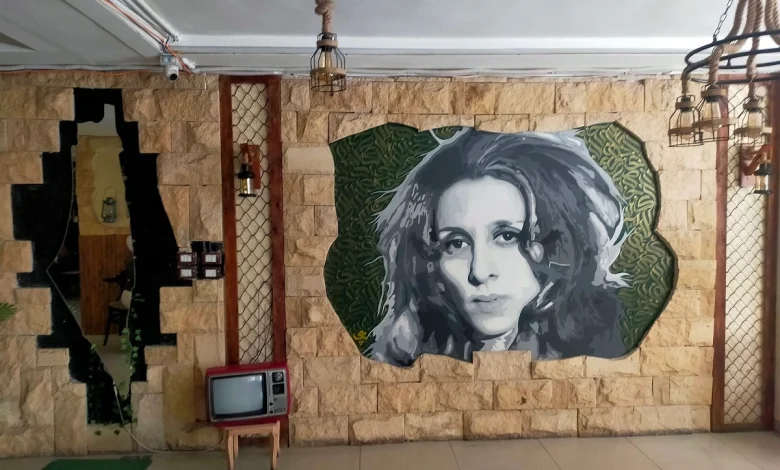
Haifa Gallery: A cultural and artistic oasis in the heart of Mansoura
“Words are not enough… to describe Haifa and its beauty.“ Perhaps these words, from the song ”Noel Kharman” about Haifa, embody the feeling that visitors to the Haifa Gallery experience for the first time, there on Abdel Azim Mahmoud Street, branching off from Al-Jalaa Street, in the Mansoura University district. And even if these words were originally written about the Palestinian city of Haifa, there is no reason why they cannot be applied to the gallery named after it.
Visitors to the Haifa Gallery are mostly people escaping the hustle and bustle of life, looking for a place to relax from the worries of study or work. There is no place more suitable than the Haifa Gallery for this purpose, as visitors are quickly captivated by the tranquility of the place, the music that speaks to their inner beauty, the antiques, the Palestinian handicrafts, and the old photographs, transporting them to a different time and place, where the breezes of Palestinian Haifa mingle with Arabic melodies and sounds.
Galerie Haifa in Mansoura: when a café becomes a free artistic and cultural space
At first glance, the gallery looks like a simple café or cultural café, serving hot and cold drinks, filled with the soft music of “Al-Zaman Al-Jamil” by Abdel Wahab, Umm Kulthum, Fairuz, Halim, and others, instilling in visitors a sense of antiquity, tranquility, and captivating beauty.

But as soon as visitors turn their gaze to the gallery, they find a small exhibition of handicrafts: necklaces, bags, bracelets, maps of Palestine, wooden sculptures, exquisite small paintings, and many Palestinian folk crafts. There are also quite a few pictures of famous artists, singers, and actors: Umm Kulthum, Abdel Wahab, Baligh, Warda, Ahmed Zaki, Suad Husni, and others. To the left of the gallery door is a mural of Fairuz, alongside which are antique items: an old television, a gramophone, an old telephone, a typewriter, an antique piano, and a radio.
From café to cultural platform: how did “Galerie Haifa” become a center for art and memory?
Visitors will also find records and tapes of the most important songs of the last century, by famous composers such as Zakaria Ahmad, Al-Qasabagi, and Al-Sunbati. And so, pieces from a distant time give the place a fascinating cultural and historical dimension. As one visitor said: “Every detail of the place, especially the beautiful era, captivates my heart. Entering the door separated me from the outside world full of technology and distractions and transported me to a beautiful era long ago.”
Indeed, little by little, visitors realize that the gallery is not just a café or coffee shop where they come for a hot drink. They quickly begin to wonder about the gallery and what it offers. The question persists: Why Haifa? Why is it so quiet? Is it always this quiet? Then they notice the sign outside that reads: “Art space & Cafe.”
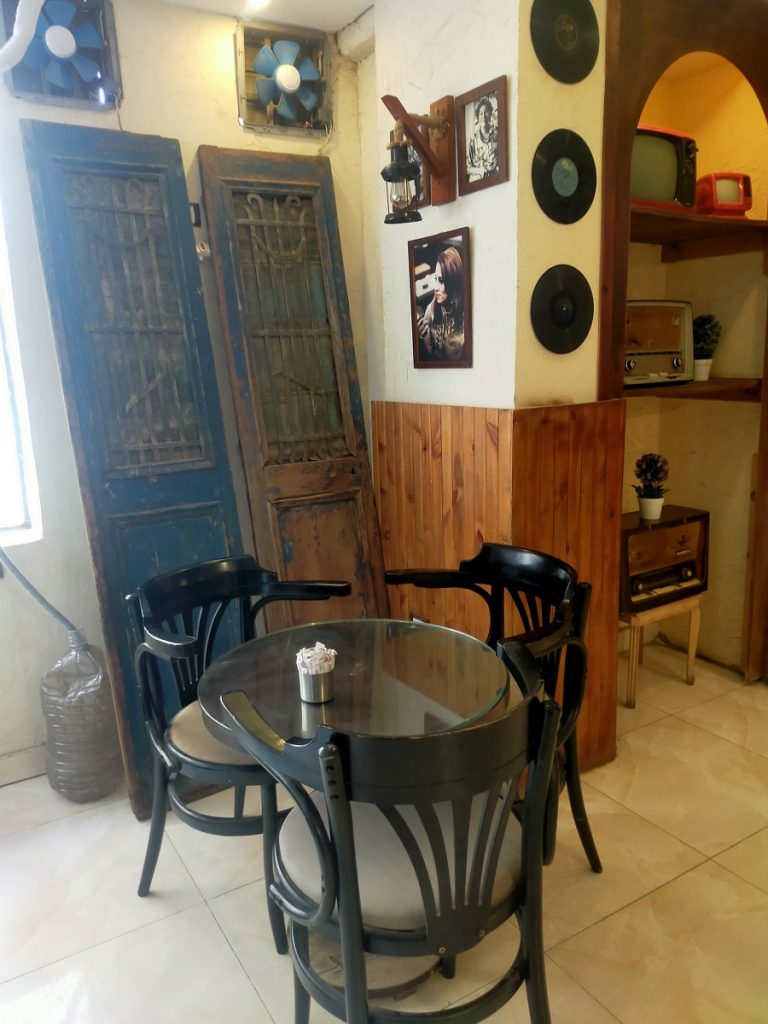
Galerie Haifa: A haven for seekers of beauty and heritage
Visitors discover an announcement for a seminar by one of Mansoura’s writers to be held on a certain day at a certain time at Galerie Haifa, or a book signing by another writer, or a poetry seminar held at the venue. Once again, they find a musical concert to be held at the gallery on a specific date, attended by artists from Mansoura and beyond, or an impromptu gathering of visitors, advertised on social media. All this makes Haifa a cultural oasis in the eyes of its visitors, welcoming all forms of art, from singing and playing to painting, sculpture, and photography, and providing them with a supportive environment.
This brings us to the story of the Haifa Gallery and its arrival in Mansoura. In 2017, brothers Mahmoud and Sameh Al-Attar began creating a traveling exhibition of handicrafts and wood carvings in downtown Cairo, displaying their work at El Sawy Culturewheel and elsewhere, until they had the opportunity to establish their first permanent exhibition.
Why Haifa?
The name dates back to the moment the gallery was founded. The brothers thought long and hard and decided they wanted to connect with the country where their parents grew up before emigrating to Egypt. They are Egyptians of Palestinian origin, from Haifa specifically. They saw the name as an opportunity to link their names to the country they were denied the right to live in and were only allowed to visit briefly, which their parents made sure to do whenever possible due to the war in the country.
Haifa is not only a personal connection for the brothers, but also an Arab cultural link between two countries that have always been in close contact. Through their gallery, the brothers seek to preserve Palestinian folk heritage and showcase it on the streets of Egypt.
Mahmoud Al-Attar adds that the gallery, with all its branches, organizes an annual exhibition on December 14 called the “Annual Palestinian Handicrafts Market,” which showcases a variety of products, including embroidery, woodwork, medals, necklaces, keffiyehs, and Palestinian clothing.

Emotional ties revive Palestinian heritage on Egyptian soil
The exhibition features artistic groups performing Palestinian dabka and a choir, as well as traditional Palestinian food. All this takes place in the branches of the Haifa Gallery in various governorates of Egypt.
The gallery was opened in 2018 through the brothers’ own efforts and with the direct help of their friends. From the very beginning, the brothers enlisted the help of artists to enrich the space with paintings on the walls and to enliven the evenings with concerts and musical gatherings. They welcomed any artistic work that could be displayed in the gallery. This gave it a unique character that was both impressive and surprising.
When does memory become an artistic work?
The idea quickly caught on, and the gallery expanded from downtown Cairo to Zamalek, then to Alexandria, Mansoura, and most recently to Zagazig. But what interests us here is the Mansoura branch and what it has added to the city. Did Mansoura need a Haifa Gallery? Does it still need more?
Mansoura, which represents the entire Dakahlia Governorate, has a rich history of struggle, art, culture, and thought. It is the city that gave birth to literary and intellectual figures such as Ahmed Hassan al-Zayyat and Anis Mansour, and to artists such as Umm Kulthum and Faten Hamama, among other luminaries too numerous to mention here.
However, the literary, artistic, and cultural movement in Mansoura has not been going well in recent decades, especially with the dawn of the third millennium.
The presence of the Haifa Gallery in the city represents an outlet for emerging and unknown artists and intellectuals, who quickly rose to prominence with the opening of the branch.
According to Mahmoud Al-Attar, the opening of the branch was based on artists from Mansoura itself and from the Dakahlia governorate in general. A number of writers have also held book signings for their new works at the branch, which opened three years ago.

Mansoura embraces Haifa: How has the gallery contributed to the revival of the local art scene?
The gallery has added a new cultural link between Mansoura and Haifa, a city that Egyptians love without ever having seen it. They have only seen its emigrants and heard the stories and tales they tell. It also provided students and university staff with a safe space to study, practice the arts, prepare lessons, and give lectures. In the morning, the gallery turns into a “work shop.”
Mahmoud Al-Attar explains that every place has its own season, or “season,” when it is crowded with visitors. The Mansoura branch’s season is during the school year, given its location in the university district. This is unlike other places, where the summer vacation is the season with the highest revenues.
Three years after the branch opened in Mansoura, the interaction between it and its patrons has proven that the city owes it a debt of gratitude and expects more cultural and artistic events from it. It is expected that investors and influential figures will recognize the importance of such places, which contribute to enriching and reviving the cultural and artistic scene and drawing attention to new artists and intellectuals. They also support the idea of cultural ties between the two cities: Mansoura and Haifa.
Read also
The birth of “Ibn Salam”… Remembering a companion who brought life back to a village in Dakahlia

